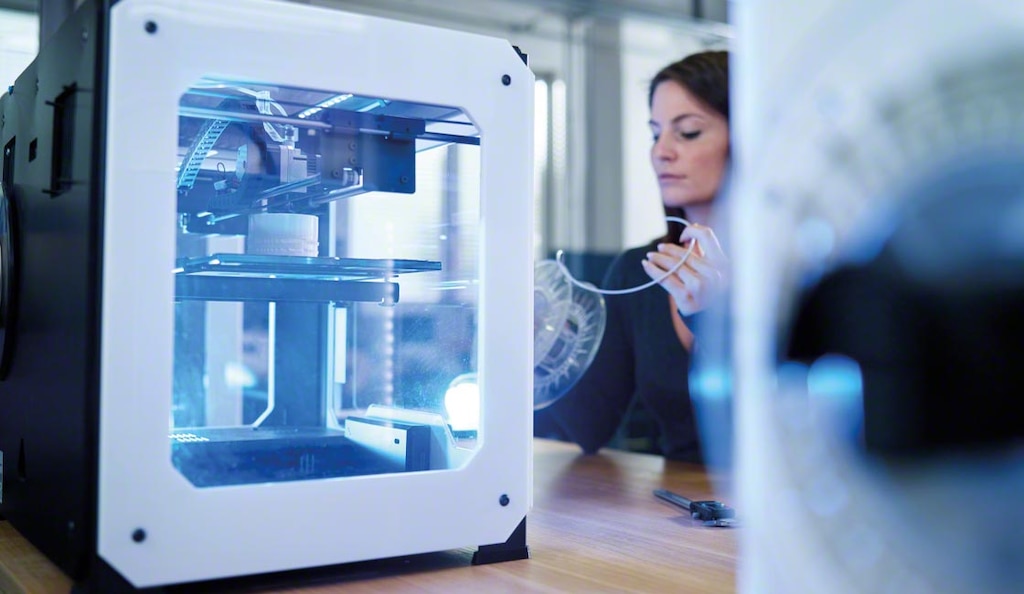
LOGISTICS RESEARCH
» Flaviana Calignano, Associate Professor, Department of Management and Production Engineering, Polytechnic University of Turin (Italy)
» Doctoral student, Department of Management and Production Engineering, Polytechnic University of Turin (Italy)
Implementing additive manufacturing technologies simplifies the traditional supply chain and reduces transport and storage costs. Likewise, it significantly curbs the production of waste. Organisations are called upon to modify their supply chains by applying lean and agile methodologies. The lean philosophy dates back to the 1970s, when the Japanese automotive industry took an approach to process management focused on reducing waste. Agile supply chains, for their part, are capable of understanding and responding to actual market demand.
These adjustments are possible thanks to new technologies such as additive manufacturing. In the past, supply chains were designed for large-volume production and cost optimisation. However, the so-called demand chains are geared towards mass customisation. These refer to the segment of the value chain that fosters profitable growth by facilitating numerous engagements between customers and a business’s brands and goods.

Additive manufacturing in the industrial sector
Additive manufacturing is the process of adding materials to create objects from 3D models, typically layer by layer, as opposed to subtractive methods. Just a few years ago, additive manufacturing was considered inappropriate for various industrial sectors. However, advancements in development have allowed its use in several of them, including aerospace, medical, automotive, fashion, food, art and jewellery. There are different techniques for carrying out 3D printing, but all follow similar steps: 3D modelling of the component, conversion to an STL file, transfer to CAM software, machine preparation, printing, removal from the platform, and, when necessary, post-processing.
The substantial impact of additive manufacturing on production processes is driven by its advantages over other traditional techniques. From an economic perspective, increasing the geometric complexity of the parts does not raise costs. 3D printing allows for the customisation and modification of objects almost instantly, using only the material strictly necessary for each output. Additionally, some inputs, such as powder, can be recycled and reused. The structures achieved are lighter, which limits fuel consumption in vehicles such as aircraft. Likewise, 3D printing can enhance supply chains by enabling small businesses to set up manufacturing centres near their customers.
While mass production is shifting to developing countries, the US and European markets are focusing on short, high-value runs characterised by innovation, personalisation and sustainability. Additive manufacturing reduces the time and costs involved in creating prototypes, thereby shortening the time it takes for a product to enter the market. Moreover, customisation enhances perceived value for consumers, making them more willing to pay.
Additive manufacturing meets lean objectives by eliminating inventory of semi-finished products. Meanwhile, the agile approach provides a competitive advantage by cutting costs on components previously manufactured by third parties.
Organisation and changes in the supply chain
Additive manufacturing can be centralised or decentralised. In the first case, parts are made in a central facility and then sent to various distribution centres. When decentralising additive manufacturing, it is possible to print from each of those locations, reducing transport costs and enabling quicker responses. Whether companies integrate additive manufacturing or implement it by subcontracting to experts in the field, employing this technology in the supply chain calls for redesigning products and processes.
Staff might lack the necessary knowledge to apply additive manufacturing techniques. Therefore, it is advisable to hire specialists or train existing personnel. In the early stages, companies should work together with 3D printer manufacturers to acquire the expertise necessary for the future. Given the sizeable initial investment required, it is recommended that businesses incorporate additive manufacturing in line with a long-term production plan.
Success stories: aircraft spare parts and sustainability
Completing repairs swiftly is essential for creating value for consumers in the aviation sector. However, for an airline, it is practically impossible to have all materials in stock: a commercial aircraft like an Airbus or Boeing plane is composed of up to four million components. Most of them are hardly ever needed, making them slow-moving parts. Thus, manufacturing them with 3D printers minimises their logistics costs. To sum up, manufacturers can continue producing standard parts using traditional techniques while simultaneously making low-demand ones. This reduces inventory levels while leveraging the advantages of additive manufacturing.
Another sector that has benefited the most from these advancements is the aerospace industry. Optimised designs can make parts 35% to 65% more lightweight and creating items requiring fewer components and materials streamlines the supply chain. Companies like Finland’s Salcomp, which specialises in outlets and power supplies for mobile phones, have tackled their bottlenecks. Salcomp’s plant in Chennai, India, detected that the cooling time of its injection moulding process was a limiting factor. Consequently, it started manufacturing the moulds employing laser powder bed fusion technology. The cooling time dropped from 14 to eight seconds, allowing the business to produce 56,000 units a month. Rejection rates also went down, from 2% to 1.4%.

Beyond those benefits, multiple materials used in additive manufacturing are recyclable. In the case of metal powder, it is estimated that 95% to 98% can be reused. Initiatives such as the Perpetual Plastic Project are analysing the possibilities of employing recycled plastics as input for 3D printing. Furthermore, a mechanical process was developed to transform waste pellets into reusable filaments for extrusion-based additive manufacturing.
Impact of additive manufacturing on reshoring
Implementing additive manufacturing enables companies to eliminate steps in the assembly phase, save on short production runs, create customised products that provide added value to customers, shorten delivery times, decrease vehicle fuel consumption and boost business flexibility. This is why numerous organisations have cited additive manufacturing as one of the reasons that led them to reshoring.
Reshoring, aka backshoring, is defined as the transfer of production back to the country of origin. It is an inverse and subsequent decision to a previous outsourcing process. Additive manufacturing removes intermediaries, lowers transport times and brings business activity closer to end customers. Its introduction implies the transition from a logic based on the producer to one centred on consumers. An example can be seen with the Covid-19 pandemic when the global community of low-cost polymer 3D printer users formed a response network to make personal protective equipment and medical supplies via a naturally decentralised human supply chain. Decentralised manufacturing often provides companies with a certain degree of protection against external disruptions and delays while reducing supply chain complexities.
Original publication:
Calignano, Flaviana, Mercurio, Vincenza. 2023. “An overview of the impact of additive manufacturing on supply chain, reshoring and sustainability”. Cleaner Logistics and Supply Chain 7 (2023), ed. K. Govindan and S. Wang (Elsevier).
